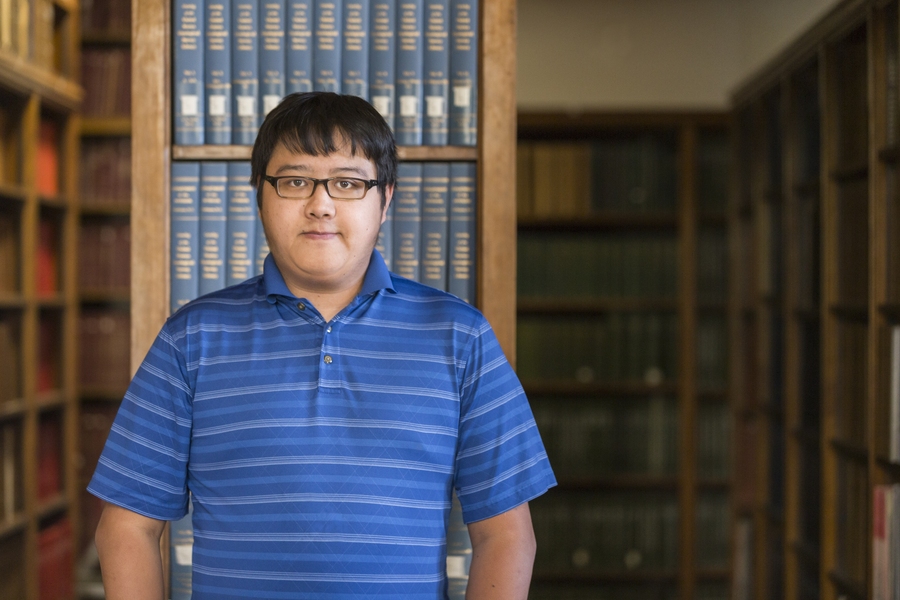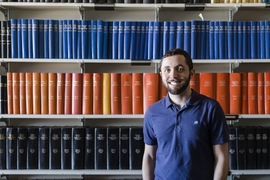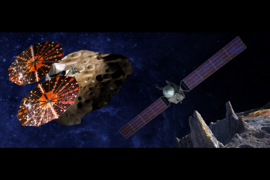The Department of Earth, Atmospheric and Planetary Sciences (EAPS) is looking forward to welcoming planetary scientist Ian Wong, one of the 51 Pegasi b Postdoctoral Fellows for 2018 announced this week by the Heising-Simons Foundation.
Named for the first exoplanet discovered orbiting a Sun-like star, the new 51 Pegasi b Fellowships are intended to give exceptional postdoctoral scientists the opportunity to conduct theoretical, observational, and experimental research in planetary astronomy.
Wong will be hosted at MIT by the Binzel Group in EAPS. Led by Margaret MacVicar Faculty Fellow and Professor of Planetary Sciences Richard P. Binzel, who is one of the world’s leading scientists in the study of asteroids and Pluto, the group’s research focuses on theory, computation, and data analysis of planetary bodies throughout the solar system.
Wong’s work seeks to decipher the history of our solar system by studying its most primitive bodies.
A visit to the Palomar Observatory as a first-year graduate student cemented Wong’s commitment to observation and hands-on data collection. His observational research focuses on small, icy asteroids in the middle and outer regions of our solar system. Astronomers consider these primitive bodies to be the building blocks of planets, providing a window into the earliest stages of our solar system — and perhaps even into the origins of life on Earth.
By studying the physical and chemical properties of these objects, Wong is working to infer details about the environment in which they formed, and uncover evidence that may support recent theories suggesting that the entire solar system once rearranged itself through a chaotic, dynamical event. Enhancing knowledge of our own solar system’s history in these ways can also help explain the observed diversity among exoplanet systems.
During his fellowship, Wong will investigate Kuiper Belt objects beyond the giant planets, as well as the Trojan and Hilda asteroids near Jupiter. He will compare the composition of these bodies to test theories of solar system formation and evolution. His planned research coincides withe the 2021 launch of Lucy, NASA’s first space mission to study Jupiter Trojans.
The Trojans are a population of primitive asteroids that orbit in tandem with Jupiter in two loose groups around the Sun, with one group always ahead of Jupiter in its path, the other always behind. At these two so-called Lagrange points, the bodies are stabilized by a gravitational balancing act between the Sun and Jupiter. Lucy’s complex path will take it to both clusters. Over 12 years, with boosts from Earth’s gravity, the spacecraft will journey to seven different asteroids in total — six Trojans and one from the Main Belt.
“These exciting worlds are remnants of the primordial material that formed the outer planets, and therefore hold vital clues to deciphering the history of the solar system,” Binzel says. Scientists hope that Lucy, like the human fossil for which the mission is named, will revolutionize the understanding of our origins.
“No other space mission in history has been launched to as many different destinations in independent orbits around our Sun. Lucy will show us, for the first time, the diversity of the primordial bodies that built the planets, opening up new insights into the origins of our Earth and ourselves,” Binzel says.
Wong explains that NASA’s Lucy mission “is a really big boon for my particular sub-field. On a fundamental level, it shows the importance of these not commonly studied objects. Throughout my fellowship, I hope to contribute important groundwork for interpreting the results of this probe.”
The big scientific question Wong will be chasing over the next three years is whether these asteroid populations are related to each other. While the traditional model of solar system evolution holds that these objects formed where they are, new insights have led scientists to theorize that an episode of dynamical instability completely rearranged the solar system.
“If that is the case, then all of the middle and outer solar system minor bodies should have formed within a single primordial population of asteroids beyond the ice giants, before being scattered into their current locations by the dynamical instability,” Wong says. “Exploring this is crucial to explaining details of solar system architecture that are left unanswered by the traditional model.”
Wong graduates from the California Institute of Technology in February 2018 with a PhD in planetary science. He holds a BA in linguistics from Princeton University.
The seven other 2018 51 Pegasi b Fellows and their host institutions are: Marta Bryan, University of California at Berkeley; Sivan Ginzburg, University of California at Berkeley; Thaddeus Komacek, University of Chicago; Aaron Rizzuto, University of Texas at Austin; Christopher Spalding, Yale University; Jason Wang, California Institute of Technology; and Ya-Lin Wu, University of Texas at Austin.
Each award provides up to $375,000 of support for independent research over three years, the time and freedom to establish distinction and leadership in the field, mentorship by an established faculty member at the host institution, and participation in an annual summit to develop professional networks, to exchange ideas, and to foster collaboration.
EAPS department head Robert van der Hilst says he is delighted that the Heising-Simons Foundation chose MIT as one of the five institutions to host the fellowship: “We are excited to welcome Ian to MIT. We are sure that his research will have an impact on our understanding of our solar system, and are honored and proud for EAPS to have been invited to host a Heising-Simons Foundation 51 Pegasi b Postdoctoral Fellow again this year.”
The Heising-Simons Foundation is a family foundation based in Los Altos, California. The foundation works with its many partners to advance sustainable solutions in climate and clean energy, enable groundbreaking research in science, enhance the education of our youngest learners, and support human rights for all people. More information about the foundation is available at www.heisingsimons.org. To learn more about the fellowship, and its four inaugural fellows, please visit www.51pegasib.org.








